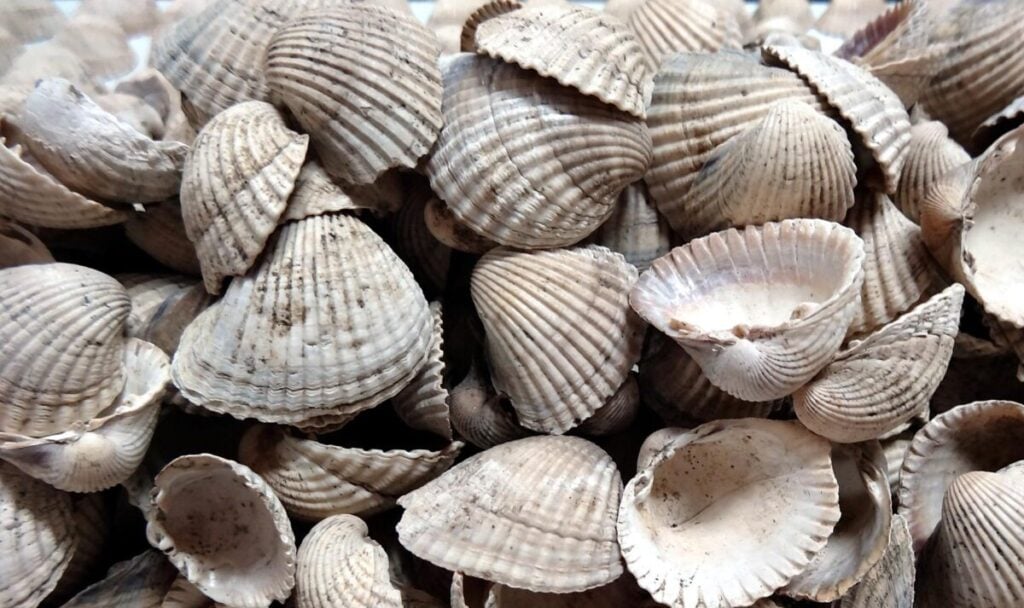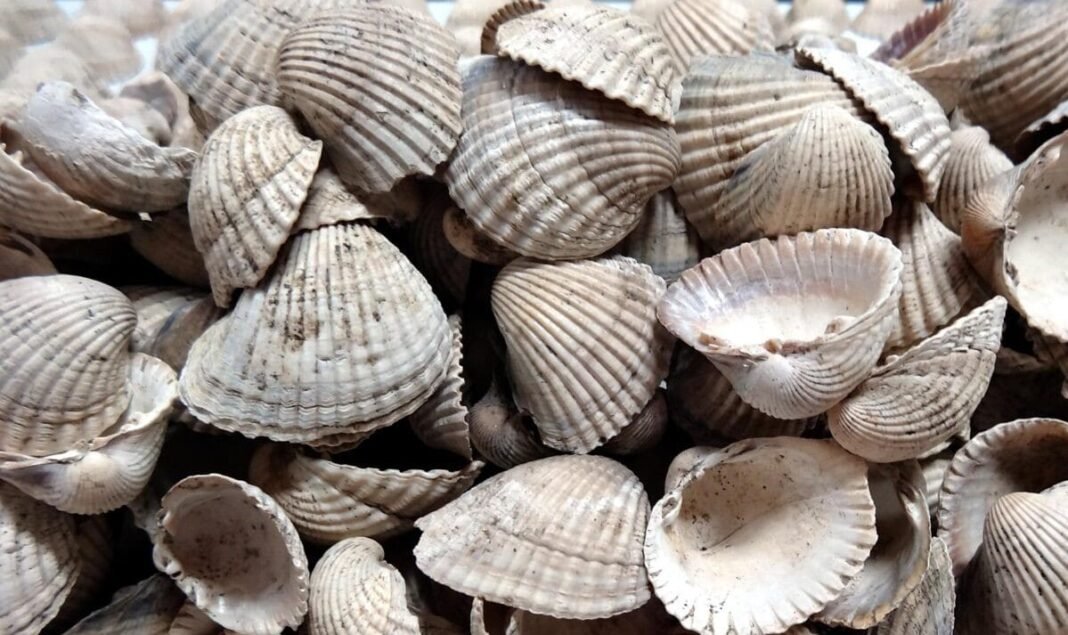
A vast Neolithic-era pit discovered in Northern Greece contained more than 130,000 shellfish, the bones of over 600 animals, and a variety of food preparation tools and utensils, offering valuable insights into the eating habits of people in the region some 7,500 years ago.
The pit was initially uncovered in the 1990s during routine excavation work for a railway line extension. It was later identified as the seaside Neolithic settlement of Makrygialos in Pieria. The trench measures approximately 30 meters (98 feet) in diameter and is between one to one-and-a-half meters (3.3–5 feet) deep. In addition to shellfish and animal bones, archaeologists uncovered millstones, clay ovens, and serving utensils.
The utensils are elaborately decorated with anthropomorphic and zoomorphic figures. Personal items, such as jewelry, were crafted from a specific type of shell considered valuable at the time. Archaeologists and geoarchaeologists estimate that the inhabitants of Makrygialos traded jewelry with other communities across Europe.
At a presentation at the Museum Store of Makrygialos, speakers Dr. Rena Veropoulidou, an archaeologist and archaeozoologist, and Dr. Nancy Krachtopoulou, an archaeologist and geoarchaeologist, delivered a lecture titled What did they eat in ancient Pieria? Long-standing traditions and innovations. The talks were based on findings from the Makrygialos Neolithic settlement.
The mystery pit of Neolithic Greece that offers insight into people’s eating habits
In speaking to the Athens-Macedonian News Agency (AMNA), Veropoulidou said:
“The pit dates back to between 5450 and 5250 BC and its use remains a mystery, although we could imagine a large gathering for a feast, with dozens or even hundreds of participants, and their remains ending up in it.”
As further excavations brought more objects to light, the question remained: was this site a Neolithic-era landfill?
“The Neolithic settlement of Makrygialos is surrounded by two very large ditches, hundreds of meters long and two to four meters deep, which were indeed used as landfills,” said Veropoulidou. “Although we could assume that this pit was also a landfill, there are elements that probably differentiate it. For example, among the finds, which were deposited there probably over a few months, there is very little soil, unlike what usually happens in a landfill.”
However, some of the findings puzzle researchers due to their remarkably well-preserved condition. “The shells, the animal bones, looked as if they had been discarded just yesterday, with the joints of the bones still intact in many cases. They did not resemble the typical landfill waste that has been exposed to the elements,” she said.
Veropoulidou noted that researchers can only form hypotheses—one being that dozens or even hundreds of people gathered for a celebratory feast, cooking and eating together before discarding the remains in the pit. The occasion might have been a wedding or harvest celebration. The presence of elaborately decorated serving utensils lends support to this theory. However, Veropoulidou added that a single ritual event cannot be ruled out, and the shell jewelry may have been intended as an offering.
Food and eating habits in the Pieria region of Greece during the Neolithic era
Many aspects of Neolithic-era people’s eating habits in ancient Pieria, Greece—spanning from around 6500 to 354 BC—remain unknown. As Veropoulidou explains, this is largely because food is perishable. “Unlike typical archaeological finds, such as pottery or stone tools, food is rarely preserved in soil, except under special conditions,” she said. “Foods that do not leave visible waste, such as grasses, vegetables, roots, or bulbs, are generally not preserved, except in rare cases in aquatic or extremely dry environments. Most often, what survives are the remnants of what had remained uneaten, such as animal and fish bones and shells.”
However, she added, burned plant remains, such as cereal and legume seeds or fruit pits, are preserved precisely because they have been charred. Nevertheless, the process of identifying small food remains, such as burned seeds or fish bones, requires great expertise, considerable time, and significant expense. For this reason, she explained, such analyses are not systematically performed during excavations. As a result, “there is loss of a tremendous, large, and significant amount of information about the past. While a statue provides information about the art of the era, eating habits provide information about the people themselves.”
As early as 6500 BC, researchers have found evidence that arable land and pastures were used on a small scale but intensively. Neolithic inhabitants primarily cultivated einkorn wheat, barley, and emmer wheat. In Revenia and Paliamela, considered among the oldest villages in Greece, the inhabitants showed a preference for einkorn wheat, which, although it yields a smaller crop, is resistant to dry climates and infertile soils, which likely explains this preference. Some researchers suggest this choice also reflects the origins of the first farmers from Anatolia and the Fertile Crescent, or perhaps served as a way to express a distinct cultural identity.
There is also evidence of the cultivation of various legumes, such as lentils, bitter vetch, and lathyrus. Remains of wild fruits have also been identified, including elderberries, figs, apples and pears, blueberries, cranberries, terebinth, grapes, plums, and cherries among others.
Although plants formed the basis of Neolithic diets, animal consumption was also significant, as studies by Paul Halstead, Valasia Isaakidou, and Anastasia Vasiliadou, among others, have shown. Domestic animals included sheep, goats, pigs, and cattle, while hunting contributed only minimally to the diet. The most commonly hunted animals were roe deer, fallow deer, red deer, foxes, hares, wild boars, and wild cattle, with turtles, hedgehogs, badgers, and bears hunted more rarely.
Neolithic peoples preferred sea urchins and shellfish
Researchers have documented that the Neolithic people of Pieria systematically exploited coastal areas and lagoons for food. They showed a preference for sea urchins, likely because the region’s many lagoons were abundant with them, though a wide variety of other seafood was also consumed.
“Northern Pieria and Makrygialos are still areas famous for their mussels, but in the Neolithic era, people consumed barnacles,” Veropoulidou said. “In fact, from the ten to fifteen interviews with residents of the area that Danae Theodorakis conducted as part of her master’s thesis, it emerged that barnacles were consumed up until World War II and that for some, they were a valuable dietary supplement during the German Occupation. People once found them in abundance in the estuaries of rivers.”
The archaeologist-archaeozoologist explained that during the Neolithic Age, a large quantity of barnacle shells was found in Methoni in the southern Peloponnese, indicating that people collected them by hand or using rakes. Given that shellfish use in Neolithic Greece dates back at least 5,500 years, it can be assumed that there was some form of semi-cultivation, such as seasonally harvesting only large-sized shells or collecting from different areas of the coastline each time so as to protect the barnacle population and ensure an annual yield.
Regarding fish consumption, data from that era is negligible. The people of Makrygialos fished for small and medium-sized fish such as seabream, black seabream, saddle bream, mackerel, sardines, and sea bass. However, analyses of the chemical composition of human bones found in Makrygialos by Professor Sevi Triantafyllou of the Aristotle University of Thessaloniki suggest that cereals and legumes formed the dietary foundation, with meat from mainly domesticated animals consumed only occasionally.
Based on the animal bones found, the animals were slaughtered and then cut into large portions for baking in ovens and pits. This is evident from the traces and marks from stone tools (e.g., knives, axes) on the bones unearthed. The size of meat portions indicates they were meant for consumption by large groups rather than a single household. Veropoulidou explained that this likely suggests meat was consumed during special occasions or festivals, when various community groups or members from multiple communities gathered.
Sustainability in Neolithic era Greece
Veropoulidou argues that the people of the time had a very close relationship with nature and their environment, passing knowledge down through generations. They appeared to understand that overharvesting vegetables or shellfish would reduce future yields. For sustainability purposes, they combined agriculture with livestock farming, using animal manure to fertilize their fields. They cultivated seasonal crops and likely allowed some areas to lie fallow.
According to Veropoulidou, this suggests that Neolithic people had a deep respect for nature and its resources. In modern terms, the communities inhabiting Greece during the Neolithic period practiced sustainable methods of farming, animal husbandry, and marine resource use—approaches that supported continuous habitation and development for nearly 8,000 years.
Today, a tradition that appears to stretch back thousands of years continues in the region. Mussel cultivation remains a defining feature, and festivals such as the annual Mydochara (Greek: Μυδοχαρά, meaning “the joy that is mussels”), held in Makrygialos, stand as a testament to this enduring heritage.
“The further south you go, the less mussels you will find. Shellfish are part of the profile of the Thermaic Gulf in general and Pieria in particular,” Veropoulidou attested. “The region could exploit this and its continuity from the Neolithic era. The diet and cultivation in the region have changed little compared to 6,000 years ago.”


